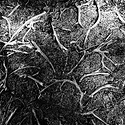Has someone found a good option for sunny scenes diluting D-76 beyond 1+1? And minimal agitation perhaps? Sun is supposed to be the place for it... Maybe a little compensation can help me make my shadows tonally closer -just a bit more- to the areas under direct sun...
The 1+1 dilution of D-76 will essentially increase the grain size, with noticeable effect at perhaps x6 enlargement. As you dilute the solvent effect decreases because sulphite is less concentrated in the liquid.
D-76 is said to be a semi-compensating developer, highlights reach lower densities than with other choices (with equal Contrast Index), reduced agitation will also help compensation, more from the bromide by-product not being evacuated from emulsion than because of developer agent local exhaustion. The effect or the bromide by-product is seen when we have a Bromide Drags event, the bromide by-product is more produced locally in the highlights and it works as a development restrainer.
It is a bit controversial if a more diluted developer will provide a higher compensation in low agitation conditions, IMO it depends on developer.
As an starting point, for very contrasty situations, you may overexpose 1 stop and underdevelop acordingly for the EI, probably you will get a more printable with also less grain, a shorter development allows grains to grow less.
Also exposure may modify the grain structure... TX structure is a bit different than the HP5 one, beyond the particular developer, digital film simulations trying to reproduce the grain nature of each place more grain in the TX shadows and more in the HP5 mids:
See how the true grain emulation software displaces the peak granularity to the mids for the beautiful HP5, being TX more dramatic (see below), this reproduces my experince, you can find many examples in flicker to see in washed areas of different exposure how the structure is...
IMO the TX challenge is not "exposure", but aesthetic grain exploitation. Regarding sensitometry you will find nuances compared to HP5, but the grain nature is totally different. TX is not better or worse than HP5, both are powerful classics with amazing aesthetic possibilities, but let me insist that while you soon will get correct exposures the grain is a complex matter, depending on the format/processing/taste you may find a deep ocean filled with opportunities.
I would you suggest to start trying different developers (concerning to grain) to find the grain capability, depending on the photograhy kind you practice. For example out offocus areas tend to show grain much better than "microcontrasty" areas, see the grain nature in the washed sky compared to HP5, or in the out of focus areas...
Also the grain evolves with shading in round volumes... helping a 3D depiction.
IMO










